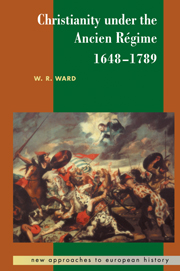Book contents
- Frontmatter
- Contents
- List of maps
- Preface
- Glossary
- 1 Peace and conflict: church and state in central and north-western Europe
- 2 Christianity in southern Europe
- 3 Catholicism in the Holy Roman Empire and the eastern Habsburg Lands
- 4 The religion of Protestants
- 5 Revival moves to the west
- 6 The Enlightenment and its precursors
- 7 The Churches in northern and eastern Europe
- 8 Religion after the Seven Years War
- Suggestions for further reading
- Index
- Title in the series
3 - Catholicism in the Holy Roman Empire and the eastern Habsburg Lands
Published online by Cambridge University Press: 05 June 2012
- Frontmatter
- Contents
- List of maps
- Preface
- Glossary
- 1 Peace and conflict: church and state in central and north-western Europe
- 2 Christianity in southern Europe
- 3 Catholicism in the Holy Roman Empire and the eastern Habsburg Lands
- 4 The religion of Protestants
- 5 Revival moves to the west
- 6 The Enlightenment and its precursors
- 7 The Churches in northern and eastern Europe
- 8 Religion after the Seven Years War
- Suggestions for further reading
- Index
- Title in the series
Summary
Witchcraft
East of the Rhine and north of the Alps (as in Italy) the Roman Catholic Church was putting down magic and inculcating Christianity however remotely after the pattern of the Council of Trent and relying on welltried Italian methods and missions. The problems of superstition were much the same in Protestant as in Catholic territories; in each there had been violent persecutions of witches in the first half of the seventeenth century, and belief in witches was connected with magic generally. One of the oddities about the witch trials was their geographical concentration. Beginning in Spain, they spread to Spanish Italy, north Italy and England, and there were powerful persecutions in southern France and Switzerland. But the worst was in the west of the Holy Roman Empire, where about half of all the executions, some 30,000, took place. In addition about the same number came off with lesser penalties and a similar number of suspects were not brought before the courts. (In Russia and the Balkans there were practically no witch trials.) For centuries there had been occasional trials of practitioners in magic; but since the later Middle Ages theologians had constructed a doctrine about witchcraft which led to charges not just of damage but of membership of a sect of witches pledged to annihilate Christianity. Once the belief got about that witches had concluded a pact with the devil, it was not difficult to credit that there were nocturnal dances or sabbaths of witches, gathering under the presidency of the devil for sexual orgies and for planning mischief.
- Type
- Chapter
- Information
- Christianity under the Ancien Régime, 1648–1789 , pp. 53 - 70Publisher: Cambridge University PressPrint publication year: 1999

